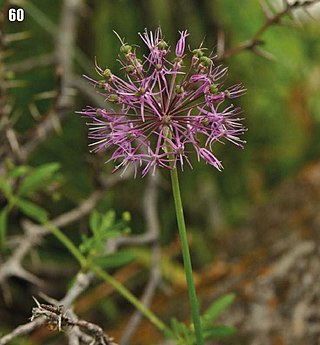
Chives, scientific name Allium schoenoprasum, is a species of flowering plant in the family Amaryllidaceae that produces edible leaves and flowers. Their close relatives include the common onions, garlic, shallot, leek, scallion, and Chinese onion.
Allium przewalskianum is an Asian species of wild onion in the Amaryllis family.

Allium macropetalum, the desert onion, is a species of wild onion native to the desert regions of southwestern United States and northwestern Mexico. It is known from desert plains and hills in Sonora, Arizona, Utah, Colorado, New Mexico, and Texas, at elevations up to 2500 m.

Allium tolmiei is a plant species native to Idaho, eastern and central Oregon, southeastern Washington, northwestern Nevada and northeastern California. It occurs on mountains and scrublands at elevations of 1,300–9,200 feet (400–2,800 m). It was discovered by and named for Dr. William Fraser Tolmie.
Allium atrosanguineum an Asian species of onion native to China, Siberia, Mongolia, and Central Asia. It grows high in the mountains at elevations of 2400–5400 m.
Allium eduardii is a plant species native to Russia, Mongolia, and northern China.

Allium fetisowii is a plant species native to Kazakhstan, Uzbekistan, Xinjiang, Kyrgyzstan and Tajikistan in Central Asia.

Allium hymenorhizum is a Eurasian species of wild onion in the amaryllis family. It grows at elevations of 1100–2700 m
Allium kaschianum is a plant species from Central Asia. It is found at elevations of 2400–3000 m.
Allium korolkowii is a plant species native to Central Asia. It grows at elevations of 1500–2500 m.

Allium lineare is a Eurasian species of wild onions with a wide range extending from France to Mongolia.

Allium macranthum is an Asian species of wild onion native to Bhutan, Sikkim, Gansu, Shaanxi, Sichuan and Tibet. It grows in wet places at elevations of 2700–4200 metres.

Allium mongolicum is an Asian species of wild onion native to Mongolia, Inner Mongolia, Tuva, Kazakhstan, and parts of China.

Allium maximowiczii, English common name oriental chive, is an Asian plant species native to Siberia, the Russian Far East, Mongolia, Japan, Korea and northeastern China.
Allium platyspathum is an Asian species of wild onion. It has been reported from Xinjiang, Afghanistan, Kazakhstan, Kyrgyzstan, Mongolia, Altay Krai, Tajikistan, Uzbekistan, and Pakistan. It grows in damp locations at elevations of 1900–3700 m.
Allium polyrhizum is a species of wild onion widespread across Zabaykalsky Krai, Kazakhstan, Mongolia, and China at elevations 1000–3700 m.
Allium schoenoprasoides is an Asian species of wild onion native to Xinjiang, Kazakhstan, Kyrgyzstan and Tajikistan. It can be found at elevations of 2700–3000 m.
Allium schrenkii is an Asian species of wild onion native to Xinjiang, Kazakhstan, Mongolia and Siberia. It grows on steep slopes at elevations of 2400–2800 m.
Allium semenovii is an Asian species of wild onion native to Xinjiang, Kazakhstan, Tajikistan, and Kyrgyzstan. It grows at elevations of 2000–3000 m.
Allium tanguticum is a Chinese species of wild onion native to Gansu, Qinghai and Tibet. It grows at elevations of about 2000–3500 m.









